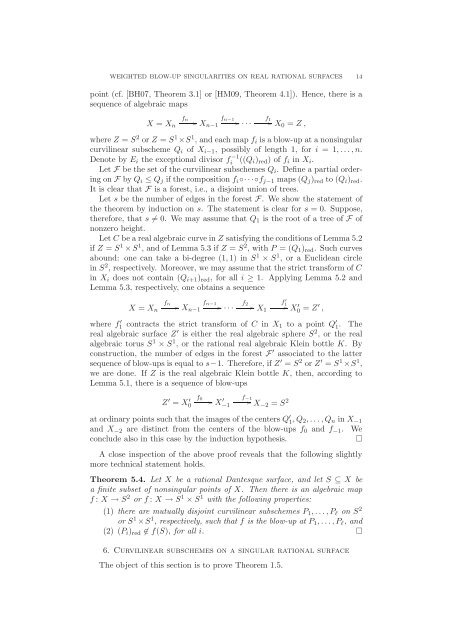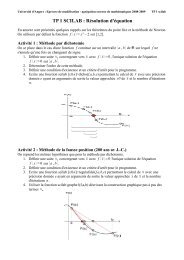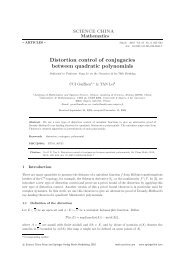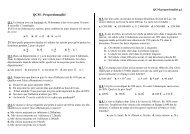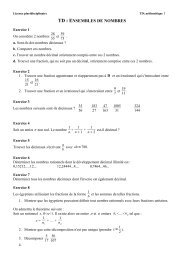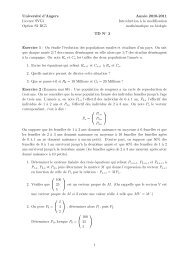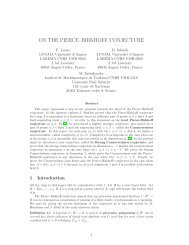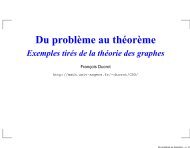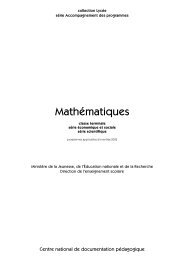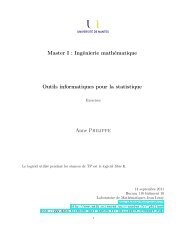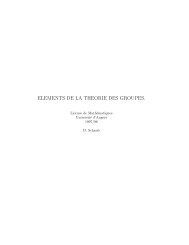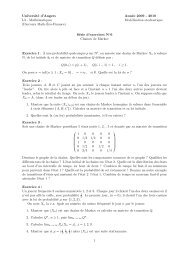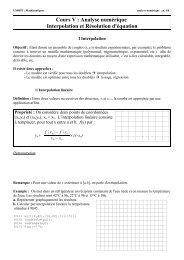automorphisms of real rational surfaces and weighted blow-up ...
automorphisms of real rational surfaces and weighted blow-up ...
automorphisms of real rational surfaces and weighted blow-up ...
You also want an ePaper? Increase the reach of your titles
YUMPU automatically turns print PDFs into web optimized ePapers that Google loves.
WEIGHTED BLOW-UP SINGULARITIES ON REAL RATIONAL SURFACES 14<br />
point (cf. [BH07, Theorem 3.1] or [HM09, Theorem 4.1]). Hence, there is a<br />
sequence <strong>of</strong> algebraic maps<br />
X = Xn<br />
fn fn−1<br />
<br />
Xn−1<br />
<br />
· · ·<br />
f1 X0 = Z ,<br />
where Z = S 2 or Z = S 1 ×S 1 , <strong>and</strong> each map fi is a <strong>blow</strong>-<strong>up</strong> at a nonsingular<br />
curvilinear subscheme Qi <strong>of</strong> Xi−1, possibly <strong>of</strong> length 1, for i = 1,... ,n.<br />
Denote by Ei the exceptional divisor f −1<br />
i ((Qi)red) <strong>of</strong> fi in Xi.<br />
Let F be the set <strong>of</strong> the curvilinear subschemes Qi. Define a partial ordering<br />
on F by Qi ≤ Qj if the composition fi◦· · ·◦fj−1 maps (Qj)red to (Qi)red.<br />
It is clear that F is a forest, i.e., a disjoint union <strong>of</strong> trees.<br />
Let s be the number <strong>of</strong> edges in the forest F. We show the statement <strong>of</strong><br />
the theorem by induction on s. The statement is clear for s = 0. S<strong>up</strong>pose,<br />
therefore, that s = 0. We may assume that Q1 is the root <strong>of</strong> a tree <strong>of</strong> F <strong>of</strong><br />
nonzero height.<br />
Let C be a <strong>real</strong> algebraic curve in Z satisfying the conditions <strong>of</strong> Lemma 5.2<br />
if Z = S 1 ×S 1 , <strong>and</strong> <strong>of</strong> Lemma 5.3 if Z = S 2 , with P = (Q1)red. Such curves<br />
abound: one can take a bi-degree (1,1) in S 1 × S 1 , or a Euclidean circle<br />
in S 2 , respectively. Moreover, we may assume that the strict transform <strong>of</strong> C<br />
in Xi does not contain (Qi+1)red, for all i ≥ 1. Applying Lemma 5.2 <strong>and</strong><br />
Lemma 5.3, respectively, one obtains a sequence<br />
X = Xn<br />
fn fn−1<br />
<br />
Xn−1<br />
<br />
· · ·<br />
f2 <br />
X1<br />
f ′ 1 X ′<br />
0 = Z ′ ,<br />
where f ′ 1 contracts the strict transform <strong>of</strong> C in X1 to a point Q ′ 1 . The<br />
<strong>real</strong> algebraic surface Z ′ is either the <strong>real</strong> algebraic sphere S2 , or the <strong>real</strong><br />
algebraic torus S1 × S1 , or the <strong>rational</strong> <strong>real</strong> algebraic Klein bottle K. By<br />
construction, the number <strong>of</strong> edges in the forest F ′ associated to the latter<br />
sequence <strong>of</strong> <strong>blow</strong>-<strong>up</strong>s is equal to s−1. Therefore, if Z ′ = S2 or Z ′ = S1 ×S1 ,<br />
we are done. If Z is the <strong>real</strong> algebraic Klein bottle K, then, according to<br />
Lemma 5.1, there is a sequence <strong>of</strong> <strong>blow</strong>-<strong>up</strong>s<br />
Z ′ = X ′ 0<br />
f0 <br />
X ′ −1<br />
f−1<br />
<br />
X−2 = S2 at ordinary points such that the images <strong>of</strong> the centers Q ′ 1 ,Q2,... ,Qn in X−1<br />
<strong>and</strong> X−2 are distinct from the centers <strong>of</strong> the <strong>blow</strong>-<strong>up</strong>s f0 <strong>and</strong> f−1. We<br />
conclude also in this case by the induction hypothesis. <br />
A close inspection <strong>of</strong> the above pro<strong>of</strong> reveals that the following slightly<br />
more technical statement holds.<br />
Theorem 5.4. Let X be a <strong>rational</strong> Dantesque surface, <strong>and</strong> let S ⊆ X be<br />
a finite subset <strong>of</strong> nonsingular points <strong>of</strong> X. Then there is an algebraic map<br />
f : X → S 2 or f : X → S 1 × S 1 with the following properties:<br />
(1) there are mutually disjoint curvilinear subschemes P1,...,Pℓ on S 2<br />
or S 1 ×S 1 , respectively, such that f is the <strong>blow</strong>-<strong>up</strong> at P1,...,Pℓ, <strong>and</strong><br />
(2) (Pi)red ∈ f(S), for all i. <br />
6. Curvilinear subschemes on a singular <strong>rational</strong> surface<br />
The object <strong>of</strong> this section is to prove Theorem 1.5.


